#Coaxial Design
Explore tagged Tumblr posts
Text
The Technical Marvel of MMCX Connectors: Precision and Performance Unveiled
In the world of audio and electronics, connectors play a pivotal role in ensuring seamless signal transmission and system integrity. Among the various connector types available, MMCX (Micro Miniature Coaxial) connectors have gained popularity for their compact design, durability, and high performance. In this article, we delve into the technical aspects that make MMCX connectors a remarkable…
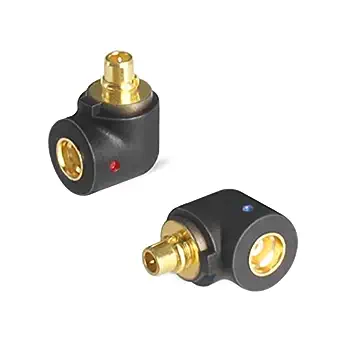
View On WordPress
#Audio Devices#Audio Equipment#Audio Quality#BNC Connectors#Cellular Signal Boosters#Coaxial Connector Technology#Coaxial Connectors#Coaxial Design#Compact Connectors#Compact Device Connectors#Connector Advantages#Connector Applications#Connector Comparison#Connector Design#Connector Durability#Connector Lifespan#Connector Locking#Connector Locking Mechanism#Connector Materials#Connector Performance#Connector Reliability#Connector Size#Connector Size Comparison#Connector Technology#Connector Technology Advancements#Connector Versatility#Corrosion Resistance#Durability Testing#Electrical Characteristics#Electrical Performance
1 note
·
View note
Text
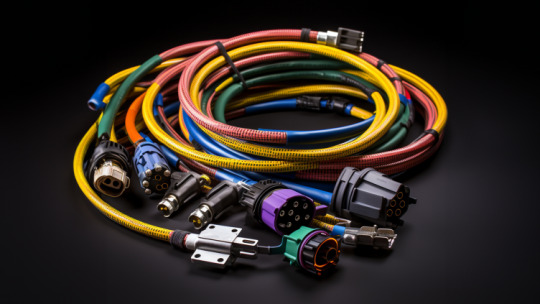
Harness Braiding & Over Mold: Elevating Cable and Wire Assembly Standards
In the intricate world of electrical systems, the quality and reliability of components play a pivotal role. As industries evolve, the demand for advanced solutions like Harness Braiding & Over Mold becomes increasingly evident. These techniques not only enhance the durability of wire harnesses, but also ensure optimal performance in diverse environments.
At Avalon, we recognize the nuances of this dynamic field. Our commitment to excellence is reflected in our adherence to industry standards and our continuous pursuit of innovation.
A Deep Dive into Avalon's Expertise
Harness Braiding & Over Mold: Our state-of-the-art techniques in harness braiding provide added protection and strength to wire harnesses. Coupled with advanced over-molding processes, we ensure that our products are resilient against external adversities and are tailored to meet specific demands.
Continuity & Hi-Pot Testing: Safety and reliability are paramount. Our rigorous continuity and hi-pot testing procedures ensure that every wire harness and cable assembly we produce meets the highest standards of electrical safety and performance.
Radio Frequency Testing: In an era dominated by wireless communication, ensuring the seamless transmission of radio frequencies is crucial. Our RF testing capabilities guarantee that our products are optimized for consistent and efficient RF transmissions.
IPC 620 Standard: Adherence to the IPC 620 standard underscores our commitment to quality. This global standard for wire harness and cable assembly ensures that our products are crafted with precision and consistency.
MIL SPEC Harness Standards: Catering to both commercial and military applications, our products are designed in line with MIL SPEC harness standards, ensuring robustness and reliability in even the most demanding scenarios.
In a domain where precision, safety, and efficiency intersect, Avalon stands as a beacon of innovation and quality. Our mastery in Harness Braiding & Over Mold, combined with our rigorous testing protocols and adherence to global standards, positions us as a leader in the cable and wire harness industry.
In a world where connections matter, Avalon is dedicated to forging bonds that last, ensuring unparalleled excellence in every wire, every cable, and every harness.
#Avalon Harness#Wire Harness Tech#Cable Assembly#Custom Harness#MILSPEC Design#Over Molding#SolderingTech#Harness Braiding#Coaxial Cable#Triaxial Cable#RF cable Assembly#Braid Cable#Electro Mechanical Harness
0 notes
Text

History's only single-seated gunship, the Kamov Ka-50 Black Shark. Its uncommon coaxial-rotor design prevents the necessity of a tail rotor, and it's also one of few helicopters in the world with an ejection seat
49 notes
·
View notes
Text
Lancer leaves the exact physical definition of a "weapon mount" kinda ambiguous, more so classifying it as "a weapon/weapons that can be fired as a single movement, without conflicting with one another." in small-arms terms, a rifle with an underbarrel grenade launcher would count as two mounts, since you can't effectively fire both at once; you either use the rifle's grip/sights/trigger, or the launcher's.
upon realizing this, i had a lot of ideas for weapon mounts that aren't just holding it in your hand, mounting it over your shoulder, or having extra arms. and that's got me thinking about some...artistic liberties with how weapons can be flavored ;)
a Heavy Machine Gun heavy mount being an autocannon integrated into the mech's torso, freeing up the arms for other mounts.
Assault Rifle main mount + Mortar flex mount as an underbarrel grenade launcher, or even overbarrel like the XM29 combination gun.
interpreting "pistol" as "one-handed reduced power firearm" and making a dual-aux flex mount with twin pistols into two scaled-up, conjoined Kriss Vectors making a bow shape, with a projector in the middle for a Charged Blade main mount following the curve of the "bow." separate mounts, because aiming the guns and swinging the blade are mutually exclusive actions.
extending this logic to the Everest's "it looks however you want" design, you could make a mid-range quadruped Everest that's effectively a walking light tank with a Thermal Lance heavy as its main gun, an Assault Rifle main as a coaxial gun or even remote weapon station and a twin Missile Rack flex as ATGM launchers on either side of the turret.
and this is all just with GMS equipment, available to everyone from the get-go, RA knows what you could get up to with different license investments. get CREATIVE with it.
42 notes
·
View notes
Text

A Wounded Fawn will be released on Blu-ray on September 24 via Shudder. The 2022 indie horror film comes with a booklet written by film critic Sabina Stent.
Travis Stevens (Girl on the Third Floor, Jakob's Wife) directs from a script he co-wrote with Nathan Faudree (Site 13). Sarah Lind, Josh Ruben, and Malin Barr star.
Special features are listed below.
Special features:
Conversations - Interviews with sculptor Charlie Becker, composer Vaaal, makeup artist Ashley Thomas, and makeup effects designer Dan Martin
On Set - Interviews with actors and costumer
Coaxial - 2022 short film by Travis Stevens
youtube
Meredith Tanning, a local museum curator, is dipping her toe back into the dating pool, only to be targeted by a charming serial killer. When a fateful romantic getaway between the two becomes a tense game of cat and mouse, both must confront the madness within him.
Pre-order A Wounded Fawn.
#a wounded fawn#shudder#horror#sarah lind#josh ruben#malin barr#dvd#gift#horror movies#horror film#vaaal#girl on the third floor#jakob's wife
12 notes
·
View notes
Text
transforming soffits reorganizing keys formalizing immersion joints justifying kick extractors advising aggregates managing elbows recasting connectors achieving aluminum trowels officiating disks exhibiting absolute spigots progressing coil hydrants jerry-building reflectors informing casters inventing rubber hoists performing wrenches judging chalk adapters upgrading ignition paths
regrowing flashing recommending ratchets approving barriers sweeping impact fillers sewing mirrors detailing collectors enforcing measures distributing systems presenting plugs interwinding registers piloting ash diffusers gathering cranks supplying eave pockets undertaking scroll stops accelerating straps designing fittings protecting diamond boilers logging downspouts correlating shingles uniting mallets qualifying electrostatic lifts sharing clamps obtaining circular fluids ranking foundation gauges sensing miter brackets originating space networks translating drills regulating guards selecting gable padding utilizing pellet dowels reconciling artifacts altering pulleys shedding space filters determining vents representing mortar remaking flash rakers supporting funnels typecasting rotary chocks expressing junctures resetting auxiliary vises professing strip treads inlaying matter trowels questioning drivers forming edge fittings sketching blanks overshooting spark breakers rewriting controls playing tunnels inventorying buttons enduring joint handles effecting ratchet bibbs unwinding couplings forsaking vapor conduits defining sockets calculating heaters raising grids administering tiles measuring resources installing ignition remotes extracting corners manufacturing ventilators delegating consoles treating mounting stones enacting jig deflectors intensifying alleys improvising cargo pinpointing bobs prescribing arc masonry structuring metal chucks symbolizing lathes activating plumb kits adapting coatings fixing channels expediting cordage planning compressors enlisting hangers restructuring keyhole augers shearing ridge hardware collecting reciprocating bolts maintaining corrugated dimmers whetting hole collars conducting mandrels comparing assets compiling sealants completing paths composing equivocation wheels computing dampers conceiving electrostatic treatment ordering cotter grates organizing ties orienting ladders exceeding materials targeting thermocouples demonstrating emery stock expanding latch bases training wardrobe adhesives overcomming[sic] fasteners streamlining storm anchors navigating springs perfecting turnbuckles verifying gate pegs arbitrating arithmetic lifts negotiating outlets normalizing strips building surface foggers checking key torches knitting grinders mowing planers offsetting stencils acquiring bulbs adopting rivets observing avenues ascertaining coaxial grommets slinging wing winches instituting circuit generators instructing wicks integrating pry shutters interpreting immersion lumber clarifying coils classifying wood bits closing cogs cataloging matter strips charting holders conceptualizing push terminals stimulating supports overthrowing shaft spacers quick-freezing connectors unbinding ground hooks analyzing eyes anticipating gateways controlling proposition rollers converting power angles coordinating staples correcting benders counseling joist gaskets recording gutter pipes recruiting drains rehabilitating rafter tubes reinforcing washers reporting guard valves naming freize sprues nominating rings noting straps doubling nailers drafting circuit hoses dramatizing flanges splitting framing compounds refitting stems interweaving patch unions placing sillcocks sorting slot threads securing mode cutters diverting catharsis plates procuring load thresholds transferring syllogism twine directing switch nuts referring time spools diagnosing knobs discovering locks dispensing hinges displaying hasps resending arc binders retreading grooves retrofitting aesthetics portals seeking stocks shrinking wormholes assembling blocks assessing divers attaining lug boxes auditing nescience passages conserving strikes constructing braces contracting saw catches serving installation irons recognizing fluxes consolidating fuse calipers mapping shims reviewing chop groovers scheduling lag drives simplifying hoists engineering levels enhancing tack hollows establishing finishing blocks
21 notes
·
View notes
Note
How big would an army of conscripts, armed with Dragunov pattern marksman rifles and iron sights, with between 1 and 3 magazines each, a radio headset that allows them to take orders on a platoon level (50 troops to be specific), and a single platoon artilleryman armed with an RPG-7 with 5 rockets, with assistance from a Mitsubishi Type 89 IFV (35mm autocannon, 7,62mm M240 pattern coaxial machine gun, tracked) and an aerial command/reconnaisance/attack/close air support aircraft, need to be to deal with an army of 1000 heavy pikemen, 50 elite knights, 200 heavy cavalry, 100 light cavalry and 200 longbowmen? The pikemen are armed with a pike and wear breastplates, pauldrons, gauntlets, a helm and chainmail. The heavy cavalry are armed with a heavy lance, a sword, cuirass and helm. Longbowmen use English yew bows and wear gambesons and a chainmail on the head. Light cavalry are armed with a spear, a short bow, and a small sword. The elite knights are armed with a heavy lance and a sword, and armoured in a full body suit of plate and horse barding, and they will move with the heavy cavalry.
Okay, so, for the record, you're not really supposed to use an SVD's iron sights. (SVD is short for “Dragunov Sniper Rifle,” so, these are formally called, “sniper rifles,” rather than just DMRs.) They were (supposed to be) issued with PSO-1 scopes. This can be a little amusing, because once you know what a PSO-1's range finder looks like, it's absolutely unmistakable, and you will see films and TV shows use them on other scopes. I bring this up, because the SVD has an effective range over 600 meters. (Specifications say it's good to almost 1.3km, but, that's very hopeful.)
However, with optics, those SVDs are going to massive out range any archer.
Your infantry have somewhere between 1k-3k packed rounds. So, if they were the only participants, they would need to be a little careful about ammo conservation. But, when you start factoring in the IFV, it doesn't matter.
This scenario isn't extraordinarily different from early battles in WWI. Where cavalry and infantry charged entrenched heavy machine gun fire, and were annihilated.
This is also a moment when the whole, “elite knight,” bit really doesn't matter. You have a minor noble, who spent almost their entire life training to be a better melee combatant. You put them in the best armor you've ever seen. And, then a bullet fired from a mass-produced sniper rifle, designed to be easily fabricated by anyone with a basic machine shop, and simple enough to be maintained by a barely literate conscript will drop them in less time than it takes to read this paragraph, before the knight even knows that someone is aiming at them.
I will say, this is a little bit of a weird combination, the Type 89 IFV, is a Japanese vehicle. The JSDF (to the best of my knowledge) has never used SVDs. These days, I think their DMR is the H&K 417. Until a few years ago, their primary infantry rifle was the Howa Type 89, which is basically a redesigned AR-18. Prior to that, they used the Howa Type 64, which was a 7.62mm battle rifle. (As far as I know, the Type 64 was domestically designed.)
The Russian/Soviet equivalent to the Type 89 IFV would be the BTR-80. As with the SVD, because it's a Romanized translation, BTR stands for, “armored carrier.” Somewhat obviously, these don't work particularly well if they're not maintained, or if the motor pool Sargent is stripping them for spare parts and siphoning gas to sell on the black market, because the government hasn't paid any of you in six months, but it's still going to have a fairly similar effect on those elite knights from the 11thcentury.
The 50 SVD rifles is weird. Full stop. It's a specialist weapon, not a general infantry weapon. In a situation like that, you'd expect to see conscripts armed with AKMs or AK74s, maybe a few SVDs and RPKs.
Now, if you were looking at a contemporary NATO unit from the 60s or 70s, then, yes, you would likely see battle rifles like the M14, FN FAL, or H&K G3. And, when you're describing using an SVD's iron sights, that's more how you have used one of those cold war era battle rifles. Also, while those rifles do have automatic settings, they're intended for semi-automatic fire.
If you're wondering why I'm not even addressing things like the areal support or the RPG, it's because they really don't matter that much. Areal reconnaissance means never having to wonder where the enemy forces are, but basically anything on this list except the RPG, could probably deal with all of the enemy forces on their own. Stacking them together would be absolutely devastating.
I'm not 100% sure, but I think you could use pretty much any modern IFV as a one-size-fits-all siege breaker if they're dealing with medieval forces.
When you're looking at modern military forces time traveling into the past, the biggest logistical issue is long term depletion of supplies. There isn't really a question of, “who's going to win? A guy with a rifle that's effective at a range of over a 1km, or 10 guys with pointy sticks. The issue is what happens in six months, or a year, when there's only three or four rounds left for that rifle on the planet, and, there won't be any more for another six hundred years.
-Starke
This blog is supported through Patreon. Patrons get access to new posts three days early, and direct access to us through Discord. If you’re already a Patron, thank you. If you’d like to support us, please consider becoming a Patron.
63 notes
·
View notes
Text

There was so much fertile ground to mine in "Vis a Vis" (S04E20, Stardate 51762.4) but nothing of consequence was produced. Tom's boredom, the coaxial warp drive that was successfully adapted, Tom and B'Elanna... all of it was window dressing at best for a by-the-numbers body-swapping plot.
My poster apes the design sense of Freaky Friday, since that is essentially what we saw Tom doing... in a "It's Voyager. Shit got freaky" way...
#star trek poster#star trek#star trek fan art#fan art#episode art#star trek art#episode poster#star trek voyager#vis a vis#tom Paris#body swap#freaky Friday
39 notes
·
View notes
Text
Types of Tanks
Most people think Light, Medium, and Heavy, but these are entirely dependant upon context. Since WWII, most tank design has gone towards Universal Tanks, either on purpose, or by accident. And throughout the short history of tanks, there has always been an effort to make thicker armour and more powerful weapons. A literal arms race.
Infantry Tank
The British literally invented tanks, and the first tank they created without foresight into what tanks could become was the Infantry Tank. The Infantry tank is designed to support infantry. This means it only needs to go as quickly as a soldier does at a march. This was back when the infantry literally walked everywhere. We are so used to vehicles nowadays that it's hard to comprehend, but if you wanted your infantry to cross Europe, they literally had to walk there. Because of the fact it does not need to move all that quickly, all of it's power can be used for armour and weaponry. This allows them to be produced for cheap, and if anyone thinks that cost is not an issue in warfare, you literally know nothing about warfare. Britain actually focused heavily on infantry tanks because of the battlefield effectiveness, and because they could achieve this battlefield effectiveness on the cheap. A few Infantry Tanks dramatically improve the capabilities of the infantry, and the majority of your land forces are infantry.
Cruiser Tank
Once you have a gap in the enemy forces, you need to exploit it, and with tanks, that was the Cruiser Tank. The British put less emphasis on this or the simple reason that it was more finicky. If you wanted armour, firepower, AND speed, you had to pay a lot of money, and it is a lot more mechanically complicated. The other reason is that horses are a thing. In the modern day, a lot of the lighter tanks would be called armoured cars. In the standard video game rating, they would be light tanks.
Because people forget who created tanks in the first place.
Breakthrough Tank
One of the main categories that would get classified as Heavy Tank. The point of a Breakthrough Tank is to heavy enough to break through enemy lines. This goes back to the original Infantry Tank Mark I form WWI to the King Tiger.
Standoff Tank
A tank powerful enough to get shot by everything the enemy has, and still fight. The problem with this is that it's impossible. On one hand, there have always been infantry anti-tank weapons, and on the other.
Air. Pursuit, Fighters, Strike Fighters, Bombs, Attack Helicopters, Drones. The Germans had plans for tanks of ridiculous proportions, even one fitted with battleship guns called a Landkreuzer.
Of course, if it's sci-fi, and the tank is big enough to equip a forceshield from a smaller ship, then things might be different.
Battleship Tank
Another failed experiment. These are tanks with multiple turrets. Like regular battleships, it turns out having one big cannon is better than multiple ones. Interbellum forces also drastically overestimated how many machineguns are actually useful. One coaxial. Maybe one for the driver. Maybe a pintle mount for Ack-Ack.
Are they cool? Oh, God yes. Not that useful, however. But incredibly cool.
Tank Destroyer
When most people think German tank tactics, they think the Blitzkrieg. Which was the most effective use of tanks in Human history, along with the first use of combined arms and mechanized brigade groups. But, contrary to popular belief, none of the cool cats took part. It was mostly Panzers II's and III's. Panzer II's had a pair of single-shot 20mm cannons.
But, later on, the II's were worthless, and the III's simply could not keep up.
The answer was to use the III's hull, remove the turret, and add a howitzer. The original plan was to use it as a self-propelled gun to accompany a panzer unit. But, the StuG III was designed too well. It's lower profile made it a perfect tank killer.
You see, tanks aren't actually designed to fight other tanks. They do often have to, but tanks are designed to break through Infantry ranks.
Because you have more of them.
When the British got the Sherman, they started adding the 17 pounder (75mm), gun... to 1 out of 4 or 5. Each troop would have one, that would often sit in overwatch as the other tanks advanced.
But the StuG had such a low profile, which made it absolutely deadly when on the defensive. Like Germany was in the second half of the war.
Modern British tank tactics don't even have them fire on the move, (and this dramatically affects accuracy), meaning that tank destroyers could in theory be used. Which is why everyone gets so butt hurt when I call the S-tank a Tank Destroyer.
Assault Gun
Big gun strapped onto a tank hull, with an armoured casement put overtop.
What's the difference between an Assault Gun and a Tank Destroyer?
Entirely practical. In fact, the original tank destroyers, (Jagdpanzers), were created as an Assault Gun. Assault Guns can have much shorter barrels, which allows them to have bigger explosives.
Here's two variants of the Tiger I (PzKpfw VI), the Jagdtiger, and Sturmtiger.
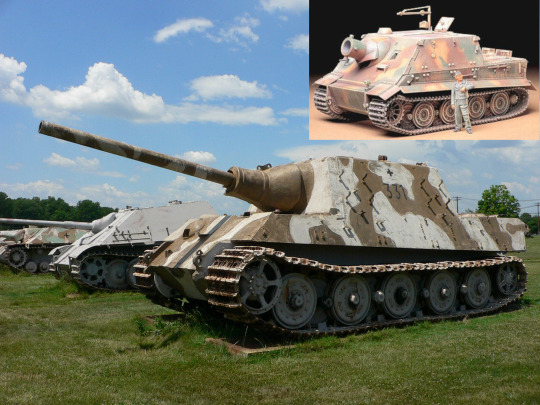
The Jagdtiger has the longer barrel and is a Tank Destroyer, while the Sturmtiger used a rocket mortar, (modified from depth charges), and is an Assault Gun. These are two extreme of the same design, with many having a lot more overlap.
The StuG III was designed as an Assault Gun, but worked so well as a Tank Destroyer that it caused Germany to make tank destroyer variants of every subsequent tank, (during the war).
Reconnaissance (Recce)
or Recon for the Yankee Doodles
Less space for big guns, more space for scanners. Because post WWII we actually had scanners that were an improvement over the Mark I eyeball, and a lens or two for magnification. They will often have room for a small group of infantry to dismount, for the simple reason that infantry are smaller, and easier to hide. It could be done without a tank, (including dirt bikes), but force reconnaissance is a thing, and they better fit in with tank platoon.
Air Mobile
Nowadays, if someone designs a Light Tank, there's a good chance it's designed to be carried by one of their standard utility aircraft. Air mobile or airborne units will benefit from any vehicle you can get them. To be entirely honest, this has never really worked, and it's difficult to get something that can actually stop bullets. For the gun, they can replace it with soft-launched missiles or a bolt cannon, and still be viable.
Engineering
Team Fortress that engineers are there to build robots. While robots are becoming more and more common, there is a huge difference between Engineer (civilian), and Combat Engineers. Combat Engineers are there to create and remove obstacles.
This doesn't sound that bad, until you realize that the obstacles are probably close to enemy lines, and they will probable object to their removing.
With machineguns.
The standard way of turning a tank into an armoured engineering vehicle is to replace the cannon with a mortar. Even a giant mortar takes up a lot less room than a standard tank cannon, and you use that for explosives. Extra points for hotrodding the engine and/or adding a dozer blade.
Armoured Recovery Vehicles
Most people think that destroying a tank means making the thing explode, leaving nothing but burnt pixels in it's wake.
In truth, the best way to stop a tank is to damage it's tracks, damage the turret ring, or liquify the crew. It turns out the squishy Humans inside the tank are easier to kill than the tank itself.
So, now that you have a dead tank on the battlefield, you need to get it off the battlefield to some place less explodey to get it repaired.
While other vehicles could definitely be used, there are a few advantages to using a tank.
Armour (obviously), as the battlefield is usually not all that safe.
Tanks are often the biggest / heaviest things on the battlefield, making the tank hull + engine one of the only things that can actually move them.
It allows that tank unit to share logistics. Every type of vehicle you had add to tank company requires it's own logistics. If you can have utility, truck, and then one type of tank chassis, you are saving yourself a LOT of trouble.
Universal Carrier
Battlefields often have terrible infrastructure for vehicles. Shockingly. Sometimes having something on track with a bit of armour is the best way to move things.
Armoured Personel Carrier / Infantry Fighting Vehicle
These are two very different vehicles in practice, but very similar in description.
APC's are to carry your infantry to the battlefield. Without infantry, tanks are extremely vulnerable to enemy infantry.
IFV's are to carry your infantry to the battlefield, and then fight with them. In fact, the iconic Bradley has a 25mm autocannon. The "Light Tank" from Command and Conquer.
Main Battle Tank / Universal Tank
By most modern definitions, the only tank, and the insane furor that literally excludes the literal first tanks.
The Universal Tank maximizes the holy trinity of tank design: Armour, Firepower, and Mobility. And, as with everything else, trying to maximize everything is difficult and expensive. Germany in WWII could probably have built at least a half-dozen StuGs for every Tiger. The only reason why the Universal Tank is considered the exclusive proprietor of the word Tank is because we literally don't have to fight any real wars. In a real war, war industry, and when talking about tanks, how many tanks you can build, is crucially important. This is why in the Ukraine/Russia conflict, they are dusting off WWII and post-bellum tanks to throw into the fray.
And using the holy trinity of tank design ignores other issues, not just your ability to build them, but your ability to maintain them.
German tanks in the later war were infamous for breaking down.
Misc.
There is a wide variety of other, more specialist armoured vehicles. From artillery, to amphibious tanks, to fascine layers, to command tanks, to flamerthrowers, to mine layers/sweepers, etc.
8 notes
·
View notes
Text
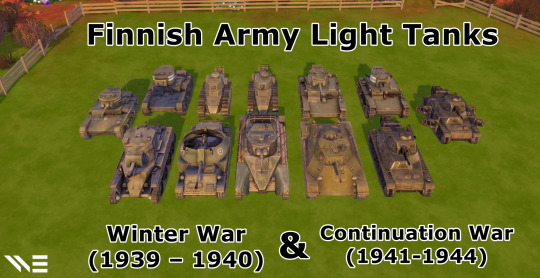

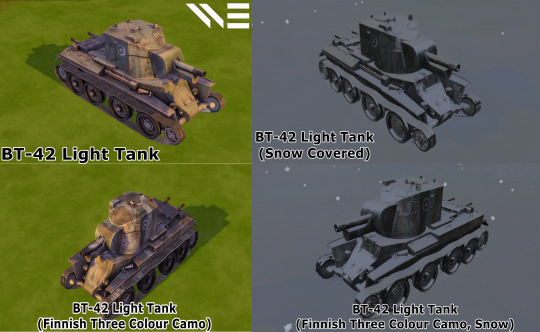








Finnish Army WW2 Light Tanks
One Of My Patron Request and Also Part Of Great Projects about Weapons and Heavy Machinery That Used During Winter War (1939-1940) & Continuation War (1941-1944) About The Finland Wars Against Soviet During during early and later Stages Of World War 2. For Your Informations Finnish Army During WW2 Heavy Machinery During Winter Wars Are Rely On Captured Soviets Tanks, Obsolete WW1 Products Or Licensed Products From Allied Countries Disclaimer:Due Heavy Censorship Regarding Swastika Usage in Western Society, The Details of The Tanks Are Replaced With Roundel Instead of Finnish Hakaristi. However It Just A Minor Details that May Missed.
DOWNLOAD Support Me In Patreon for Exclusive Business Agreement Or Support Me In Paypal For One-Time Support
BT-5 Light Tank The BT tanks (Russian: Быстроходный танк/БТ, romanized: Bystrokhodnyy tank, lit. "fast moving tank" or "high-speed tank") were a series of Soviet light tanks produced in large numbers between 1932 and 1941. They were lightly armoured, but reasonably well-armed for their time, and had the best mobility of all contemporary tanks. The BT tanks were known by the nickname Betka from the acronym, or its diminutive Betushka. The successor of the BT tanks was the famous T-34 medium tank, introduced in 1940, which would replace all of the Soviet fast tanks, infantry tanks, and medium tanks in service.
This Particular Variant is BT-5: Armed larger cylindrical turret, 45 mm 20-K gun, coaxial DT machine gun. Earlier tanks used simpler fully cylindrical bolted turrets with rear bustle welded on.
BT-42 Light Tank During the WWII, the Finnish Army utilized captured Soviet tanks as their significant armament. Among these was the BT-42 assault gun which the Finnish Army created by pairing the hull from a captured Russian BT-7 Model 1937 light tank with a British 114mm howitzer and a redesigned BT-7's large boxy turret. 18 units were produced from 1943 to 1944 and they were deployed to the Svir River region to attack the Russian bastion. In June 1944 during the Battle of Vyborg, BT-42s saw fierce combat against advancing Russian forces.
Renault FT-17 Light Tank
The Renault FT (frequently referred to in post-World War I literature as the FT-17, FT17, or similar) was a French light tank that was among the most revolutionary and influential tank designs in history. The FT was the first production tank to have its armament within a fully rotating turret. The Renault FT's configuration (crew compartment at the front, engine compartment at the back, and main armament in a revolving turret) became and remains the standard tank layout. Consequently, some armoured warfare historians have called the Renault FT the world's first modern tank. Over 3,000 Renault FT tanks were manufactured by French industry, most of them in 1918. After World War I, FT tanks were exported in large numbers. Copies and derivative designs were manufactured in the United States (M1917 light tank), in Italy (Fiat 3000) and in the Soviet Union (T-18 tank). The Renault FT saw combat during the interwar conflicts around the world, but was considered obsolete at the outbreak of World War II.
This Model Armed with Puteaux SA 1918 37 mm gun While The Other , Equipped With 8mm Hotchkiss Mle 1914 Machine gun for Anti-Personnel Purpose (Not Showed in Review)
KhT-130
KhT-130 is Flamethrower variant of model 1933 which is Variant Of Soviet T-26 Tank, The Most Successful and Most Modular Pre-WW2 Light Tanks using a larger 45 mm gun turret (a gun was replaced with a flamethrower for Anti-Personnel Purpose).
Landsverk L-62 Anti II
Landsverk L-62, also known as Landsverk Anti II or a combination of both, Landsverk L-62 Anti II, was a Swedish self-propelled anti-aircraft gun construction that was specifically designed for Finland by Landsverk between 1941 and 1942.
The vehicle was an improved Landsverk L-62 Anti I where the turret and chassis had been improved for better protection. The chassis was based on the Landsverk L-60 tank but was lengthened with one extra roadwheel per side. The turret was circular and open for a better view against planes. The gun was a 40 mm Bofors L/60 anti-air gun which was already in service with the Finnish military as the 40 ItK/38.
Vickers Mark E
The Vickers 6-ton tank or Vickers Mark E, also known as the "Six-tonner" was a British light tank designed as a private project at Vickers. It was not adopted by the British Army, but was picked up by many foreign armed forces. It was licensed by the Soviet Union as the T-26. It was also the direct predecessor of the Polish 7TP tank.
Hotchkiss H39 Light Tank (German:PzKpfw 38H-735)
The Hotchkiss H39 (a variant of the Hotchkiss H35) was captured and used by Germany as the PzKpfw 38H-735.
The Hotchkiss H35, or Char léger modèle 1935 H, was a French light tank developed prior to World War II. Despite having been designed from 1933 as a rather slow, but well-armored, light infantry support tank, the type was initially rejected by the French Infantry because it proved difficult to steer while driving cross-country, and was instead adopted in 1936 by the French Cavalry. In 1938, an improved version was produced with a stronger engine, the Char léger modèle 1935 H modifié 39, that from 1940 was also fitted with a longer, more powerful 37 mm gun. It was intended to make this improved variant the standard light tank, and was to be produced in a number of at least four thousand in order to equip new armored divisions of both the Cavalry and the Infantry. However, due to the defeat of France in June 1940, total production of both subtypes remained limited to about 1200 vehicles. For the remainder of the war, Germany and its allies would use captured Hotchkiss tanks in several modifications.
Hotchkiss H39 Light Tank (German:Panzerkampfwagen 38H 735(f))
Variants of A Captured Hotchkiss H39 Tank by German, Outfitted with Nebelwerfer 42, A 30mm German Rockets.
Soviet T-50
The T-50 was a light infantry tank built by the Soviet Union at the beginning of World War II. The design for this vehicle had some advanced features, but was complicated and expensive, and only a short production run of 69 tanks was completed.
Soviet T-26
The T-26 tank was a Soviet light infantry tank used during many conflicts of the 1930s as well as during World War II. It was a development of the British Vickers 6-Ton tank and is widely considered one of the most successful tank designs of the 1930s. It was produced in greater numbers than any other tank of the period, with more than 11,000 produced. During the 1930s, the USSR developed approximately 53 variants of the T-26, including other combat vehicles based on its chassis. Twenty-three of these were mass-produced. The T-26 was used extensively in the armies of Spain, China and Turkey. In addition, captured T-26 light tanks were used by the Finnish, German, Romanian and Hungarian armies. Though nearly obsolete by the beginning of World War II, the T-26 was the most important tank of the Spanish Civil War and played a significant role during the Battle of Lake Khasan in 1938 as well as in the Winter War in 1939-40. The T-26 was the most numerous tank in the Red Army's armored force during the German invasion of the Soviet Union in June 1941. The Soviet T-26 light tanks last saw use in August 1945, in Manchuria. The T-26 was reliable and simple to maintain, and its design was continually modernized between 1931 and 1941, with a total of 11,218 vehicles built. However, no new models of the T-26 were developed after 1940.
Soviet T-26E
Variant Of Soviet T-26 tank with additional armour plating (appliqué armour). Some modern sources mention this tank as T-26E (E stands for ekranirovanny or "screened"). The Factory No. 174 developed the design of 30–40 mm appliqué armour for all types of single-turreted T-26s during the Winter War. On 30 December 1939, factory tests proved that the T-26 with appliqué armour successfully resisted fire from a 45 mm anti-tank gun at a range from 400 to 500 m. Side and front armoured plates were mounted with the use of blunt bolts and electric welding. Toward the middle of February 1940, the RKKA received 27 screened T-26 mod. 1939 tanks and 27 KhT-133 flame-throwing tanks; an additional 15 T-26 mod. 1939 tanks were armoured by workshops of the 8th Army in Suoyarvi in the beginning of March 1940. All in all, 69 T-26s with appliqué armour were used during the Winter War and 20 more were delivered to tank units after the end of the war. Combat use proved that Finnish light anti-tank guns could not penetrate the armour of these tanks.
#the sims 4#the sims#the sims 4 custom content#ts4 cc#ts4military#the sims 4 military#ts4#the sim#the sims 4 cc#ts4cc#finland#soviet union#winter war#the sims 4 decades challenge#ts4 decades challenge#the sims 4 decor#russian tanks#Tanks#the sims 4 build#sims 4 decades#decades challenge#1930s#1940s#Sims 4 war#world war 2#the sims 4 ww2#ww2#light tank
41 notes
·
View notes
Note
Hey I have one of those little tvs too howd u do the broadcast setup
I've been trying to research how it works but a lot of the technical details confuse me
required equipment: RF modulator with correct format for your TV (PAL for european, NTSC for north american/japanese), HDMI to AV downscaler (unless you're using a device with AV output for the stream source, or your RF modulator has HDMI input), TV antenna (i just used a little pair of rabbit ears from target), and, optional but recommended: signal amplifier. and of course a tv with an antenna.
connect your TV antenna and optional amplifier to the RF modulator's output - normally you would use a coaxial cable to connect this directly to the TV's antenna input, but in this case we're being silly and sending the signal over the air instead, which it is not designed for.

connect your source device (i'm using a roku) to the HDMI downscaler if necessary. then, connect the downscaler (or the source device if not using a downscaler) to the RF modulator's input.
plug in any devices that need external power, and then tune your TV to the channel the RF modulator is set to - on NTSC modulators, this is usually by default channel 3 or 4. the one i'm using defaults to whatever it was set to last, which was NTSC 14.

enjoy your low fidelity! using this setup WITH the amplifier the broadcast range is about 3 feet, but it drops off significantly over one foot away. if you used a real transmitter the results would be better. but we're not doing that.

8 notes
·
View notes
Video
NX30033, Hiller XH-44 Hiller-Copter, NASM Silver Hill, Maryland, 09-08-1974 by Gordon Riley Via Flickr: The XH-44 was the first helicopter with coaxial rotors to fly successfully in the United States. The XH-44 was also the first helicopter to fly successfully with all-metal blades and a rigid rotor. It was designed in 1944 by Stanley Hiller, Jr. who was 19 at the time.
18 notes
·
View notes
Text
My retro setup
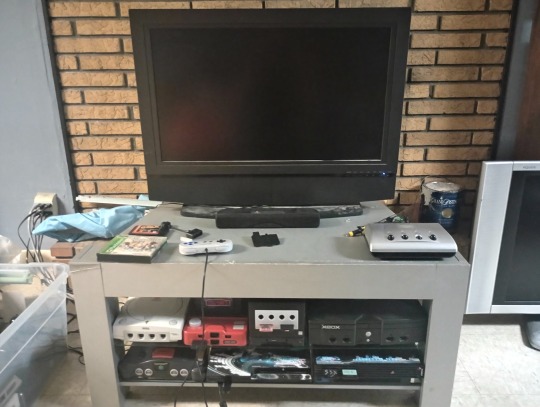
If you're a retro person younger than me, you probably emulate old games on your laptop, or even your phone. But I'm a freak, so I set up space in my room to play old games on original-ish hardware. This is by no means the easiest method or even that much more authentic than just emulating, but the vibes are nice. Lemme give you a tour.
The first thing you may notice is I don't use a CRT. I do have a Sony Trinitron, and I even tried to get it set up, but I'm in a basement and getting it down here requires renting an industrial dolly designed for stairs. So I compromised and snatched a 2006 Olevia flatscreen from my dad. Flatscreens are honestly more nostalgic to me than CRTs anyway, and they're much more practical to use. They're lighter, more compact, and they have an ungodly number of inputs. The speakers aren't great though, so I also put in a soundbar.
I really wanted to use the Sharp Aquos you see cropped out on the right, but it sadly won't turn on. I plug it in occasionally in the hopes that it someday just starts working again, but alas. I really like that TV too.

The consoles! These are all plugged into an S-video adapter unless stated otherwise. From top-left to bottom-right.
I'm honestly not sure why I hooked up the Sega Dreamcast. Probably because I had space for it. I could hard-mod it, which is surprisingly easy to do, but most everything worth playing on the system has a better version on another platform. So it's there as a filler. If I ever get a Sega Saturn I'll probably replace it with that.
I was gonna put in a Sega Genesis, but the Olevia weirdly doesn't have the channels required to read any coaxial systems. So I went even more compact and bought a Retron 3. I had a Retron 2 HD that could play NES/SNES games, but the composite would only output in black & white. So I just bought a new one with no HD compatibility that also supported Genesis carts. All three slots utilize flashcarts to maintain the health of both the console and my individual games. This is the only console plugged in through composite.
The GameCube was the first console I modded when I got the idea for this setup. I do unfortunately have to use my copy of Twilight Princess to run the mod, but that may change as m.2 loaders for the system get developed. I also have a GBA flashcart I could plug into the Game Boy Player beneath it, but that's currently in my actual GBA.
The Xbox is an eldritch nightmare and I highly advise against any form of modding. I bricked it on accident trying to help a streamer unlock the region on his, and the process of unbricking it was such a goddamn nightmare that I refuse to do any further mod fuckery. Anyone who said this is the best modded console ever is a liar. Most games worth playing on this system are backwards compatible on Xbox One/Series X, so it's mainly here for insurance whenever Microsoft decides to shut those consoles down.
The N64 doesn't have much special going on. It's got a flashcart and I have some Hyperkin controllers for four-player shenanigans, though last time I used the system it would reset on its own. I think one of the controllers has a reset button in its stick or something, which is a really irresponsible place to put a reset button. Ah well.
Hey why do you have a PS3 plugged in? That's hardly retro.
Well technically the PS3 fits the vibe in a 2000s-era retro space, and I'm sure some of you can feel your skin wrinkle as I say that. But the real reason it's there is to play PS1 games. Theoretically a PS3 can be softmodded to play PS1 ROMs off a USB drive, but I could never get that to work. Lemme know if you got it working and how. In the meantime I can at least play PS1 discs. This is the only console plugged in through HDMI.
It can't play PS2 games though, which is why I have a PS2 set up as well. This is my preferred console for most retro games, on account of being the only one with a drive bay. Its one annoyance is third-party network adapters (required to plug in the drive) don't actually have network ports, and I can't load ROMs through USB or similar. So if I want to add new games, I gotta remove the drive manually and plug it into my desktop. It also can't play PS1 games, since the console is hard-coded to shut out both USB and the drive bay when loading its PS1 emulation. But it works great for PS2 games, and that's all it needs to do.
I should reiterate again that you don't need to do this to have a true authentic experience playing retro games. As time goes on, emulation & 4K OLED TVs will be more accessible means of achieving authenticity. I'm just a madman who had the space & resources to do it.
1 note
·
View note
Text
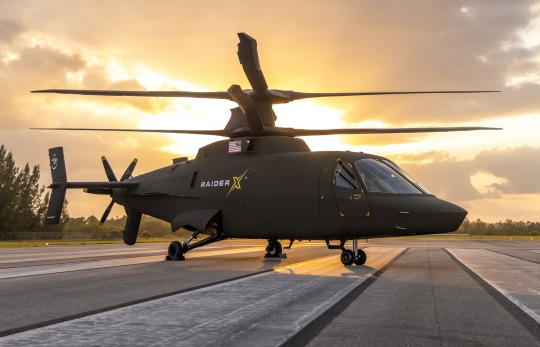
Sikorsky reveals RAIDER X prototype for the US Army FARA competition
The program of the new armed reconnaissance helicopter aims to develop a successor to the Bell OH-58 Kiowa.
Fernando Valduga By Fernando Valduga 10/22/2023 - 20:42 In Helicopters
Almost a decade ago, the U.S. Army withdrew its latest helicopter designed specifically for the attack reconnaissance mission - the OH-58 Kiowa Warrior. Sikorsky has now presented the RAIDER X, its concept for a fast, agile and capable composite coaxial helicopter that will equip future aviators to face evolving threats from peers and near peers in the most difficult environments.
As the video in this post highlights, the RAIDER X was specifically designed as a prototype for the prototype competition of the U.S. Army's future armed reconnaissance aircraft (FARA), part of the U.S. Army's effort to revolutionize its enduring aircraft fleet as part of what is known as Future Vertical Lift (FVL).
youtube
Since retiring the OH-58 Kiowa Warrior fleet, a combination of AH-64 Apache helicopters and unmanned aerial vehicles (UAVs) have been used as replacements, performing the attack reconnaissance mission in the best possible way.

But similar threats require next-generation aircraft specially designed to stay ahead of combat through continuous evolution. Unlike the Kiowa Warrior, the FARA, the main priority of modernization of Army Aviation, is a strategic resource at the level of the Division, Corps and Joint Forces that operates in the depths of the battle space. And it is the only reconnaissance platform that offers deep reach, providing a level of survivability never before obtained in Army Aviation.
Sikorsky, one of the two companies competing for FARA (the other is Bell with Bell 360 Invictus), is offering RAIDER X. Flying low and fast to stay hidden below the tree line, RAIDER X will provide crucial intelligence and keep forces connected through a secure communications network. Built to find, fix and end anti-access/anti-denial (A2AD) and enemy forces, RAIDER X operates in contested environments at the front of the fight. It is a sophisticated sensor, a central network hub and a powerful armed reconnaissance helicopter, all in one.
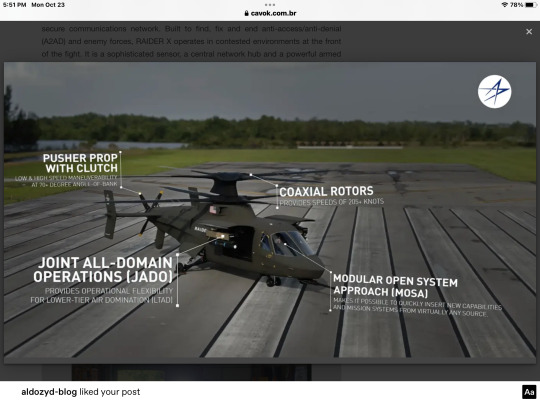
“RAIDER X is a complete weapons system,” said Jay Macklin, Sikorsky's director of FVL Business Development and retired U.S. Army aviator, in a Sikorsky press release. “It provides significant reach, survivability and lethality – much more than exists in today's enduring fleet. RAIDER X will be connected to the network as a key part of the combined armed force, allowing the ground commander to see and shape the battlefield."
With an increasingly complex future threat environment and a rapid pace of technological change, allowing quick updates and putting real-time decision-making closer to combat is critical to the success of the mission. RAIDER X was developed specifically with the Army's Modular Open Systems (MOSA) Approach to provide advanced capacity and allow for fast upgrades. Its adaptability is the starting point for decades of innovation.
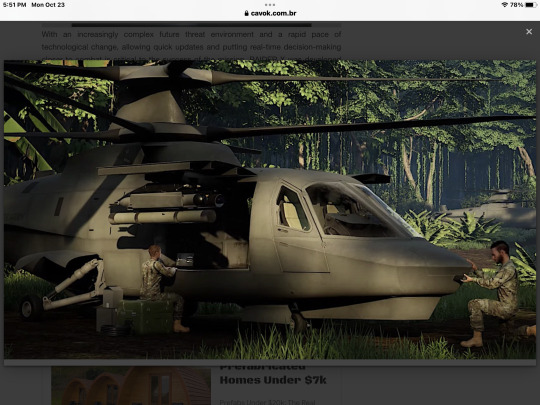
This fusion of superior physical performance with transformational digital capabilities is exactly what Lockheed Martin's 21st Century Security strategy seeks to achieve - to help fighters meet the challenges of future multi-domain missions.
X2 technology, the basis of Sikorsky's coaxial helicopter design, allows the RAIDER X to fly faster and farther than single main rotor helicopters, while carrying a significant payload. The speed, range and integrated mission systems of RAIDER X make it an especially effective and improved strategic resource in the vast expanses of the Indo-Pacific region.

The X2 designs also allow the inherent growth of the weapon system compared to the limitations of single main rotor aircraft. All these attributes allow RAIDER X to operate at longer ranges with higher speed to the target and a high degree of situational awareness.
With its maneuverability at low and high speed, the RAIDER X stands out in the lower-level air domain (LTAD) - the space between the ground and 30 meters. RAIDER X is a networked sensor package that supports the joint domain, providing greater flexibility to the joint force commander.
Tags: Military AviationFARA -Future Attack Reconnaissance AircraftFVL - Future Vertical LiftHelicoptersRAIDER Xsikorsky
Sharing
tweet
Fernando Valduga
Fernando Valduga
Aviation photographer and pilot since 1992, has participated in several events and air operations, such as Cruzex, AirVenture, Dayton Airshow and FIDAE. He has work published in specialized aviation magazines in Brazil and abroad. Uses Canon equipment during his photographic work in the world of aviation.
Related news
INTERCEPTIONS
VIDEO: Russian fighters follow British warplanes over the Black Sea near Russian airspace
22/10/2023 - 20:06
MILITARY
South African Air Force has 85% of its aircraft without flight conditions
21/10/2023 - 09:00
HELICOPTERS
Croatia transfers 14 Mi-8 helicopters to Ukraine
20/10/2023 - 19:17
MILITARY
Diehl Defense establishes cooperation with the Korean industry for the KF-21 program
20/10/2023 - 17:00
MILITARY
NATO intensifies patrols in the Baltic Sea after damage to submarine infrastructure
20/10/2023 - 16:00
HELICOPTERS
Patria and United Aero Group will jointly offer UH-60 Black Hawks in the European market
20/10/2023 - 14:00
6 notes
·
View notes
Text
M60 “Patton” research
M60 “Patton”
The M60 is an American MBT that was designed in response to the soviet T-55 and was a direct upgrade of the M48 Patton. The reason I have Patton in quote marks is because it wasn’t actually made a part of the Patton series of tanks but it was a direct upgrade form a tank that was. The reason some tanks were called Patton is because there was a line of tanks named after the American second world war tank general George Patton. The M60 was armed with one 105mm M68 cannon, one coaxial 7.62mm M240 and one 12.7mm M85 antiaircraft gun on the roof. I think the M60 would make a good fit to the game as it was made to be a direct competitor to the Soviet T-55 which is the MBT I want to use for WTO so having it’s competitor be the NATO tank I think would be a good idea.
M60

M48 Patton
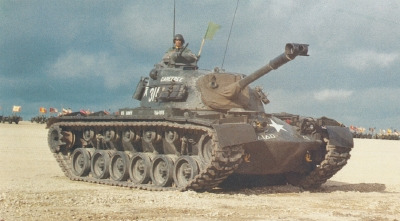
13 notes
·
View notes
Text
5 Tips in Choosing the Best Car Speakers to Rev up Your Mood

Music has the power to enhance our moods and make any experience more enjoyable, including driving. A good set of car speakers can make all the difference in transforming your daily commute or road trip into a memorable experience. However, with so many options available in the market, it can be tough to choose the best car speakers for your vehicle. In this article, we will provide you with some tips to help you choose the best car speakers that will turn up your mood and provide you with an immersive audio experience while on the road.
Types of Car Speakers
Before we dive into the tips, let's take a look at the different types of car speakers available. The most common types are component speakers, coaxial speakers, and subwoofers. Component speakers offer the best sound quality but are also the most expensive. Coaxial speakers are a more affordable option that combines the woofer and tweeter in one unit. Subwoofers are designed to produce low-frequency sounds and are usually used in conjunction with other speakers. Tip #1: Consider the Size Before purchasing car speakers, it's important to check the size of your current speakers. This will ensure that the new speakers will fit properly in your vehicle. Most car speakers come in standard sizes, but some vehicles may require custom sizes. It's also essential to consider the depth of the speakers. If the new speakers are too deep, they may not fit in your car's door panel. Tip #2: Determine Your Budget Car speakers range in price from budget-friendly to high-end. It's important to determine your budget before making a purchase. Keep in mind that you get what you pay for. Higher-priced speakers usually offer better sound quality and durability. However, some budget-friendly options still offer decent sound quality. Tip #3: Check the Sensitivity Rating The sensitivity rating of a speaker is an important factor to consider. It measures how much sound a speaker can produce with a given amount of power. Speakers with higher sensitivity ratings require less power to produce the same amount of sound compared to speakers with lower sensitivity ratings. This means that speakers with higher sensitivity ratings are more efficient and will work better with low-powered car stereos. Tip #4: Look for a Good Frequency Response The frequency response of a speaker measures the range of frequencies that it can reproduce. A speaker with a wider frequency response can produce a broader range of sounds, resulting in better sound quality. Look for speakers with a frequency response of at least 20 Hz to 20 kHz, which is the range of human hearing. Tip #5: Consider the Power Handling Power handling refers to the amount of power that a speaker can handle without getting damaged. It's important to match the power handling of the speakers to the power output of your car stereo. If the speakers can't handle the power output, they may get damaged or produce poor sound quality. It's also important to note that higher power handling doesn't necessarily mean better sound quality.
Conclusion
Choosing the right car speakers is crucial to make your driving experience more enjoyable and entertaining. By considering the type of speaker, size, budget, sensitivity rating, frequency response, and power handling, you can make an informed decision and select the best car speakers that suit your needs. With the right car speakers, you can enjoy your favorite music while on the road and make your daily commute or road trip a more memorable and enjoyable experience. So, go ahead and invest in a good set of car speakers to rev up your mood and elevate your driving experience. Upgrade your car audio experience today with FS-ELEC's premium car speakers. Visit our website now to explore our range of top-tier auto speakers and take the first step towards an amazing audio experience on the go. Don't settle for mediocre sound quality; choose FS-ELEC and elevate your music game with unparalleled sound clarity and quality! Read the full article
4 notes
·
View notes